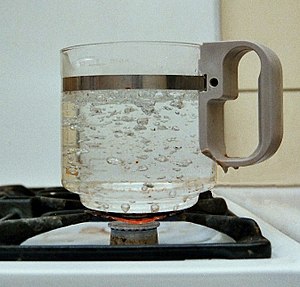ക്വഥനാങ്കം
ഒരു ദ്രാവകം ചൂടാക്കുമ്പോൾ അതിന്റെ വാതകത്തിന്റെ മർദ്ദം (Vapor pressure) ദ്രാവകത്തിനു പുറത്തുള്ള മർദ്ദത്തിന് തുല്യമാവുന്ന താപനിലയാണ് ക്വഥനാങ്കം അഥവാ തിളനില. മർദ്ദം വർദ്ധിക്കുന്നതിനനുസരിച്ച് ക്വഥനാങ്കവും വർദ്ധിക്കുന്നു. അന്തരീക്ഷമർദ്ദം കുറവായ മലമുകളിൽ ജലം പെട്ടെന്ന് (താഴ്ന്ന താപനിലയിൽ) തിളയ്ക്കാൻ കാരണം ഇതാണ്.[1][2][3]

ദ്രാവകത്തിനു പുറത്തുള്ള മർദ്ദം സമുദ്രനിരപ്പിലെ അന്തരീക്ഷമർദ്ദത്തിന് (1atm) തുല്യമാകുമ്പോഴുള്ള ക്വഥനാങ്കത്തെ സാധാരണ ക്വഥനാങ്കം (Normal boiling point) എന്നു പറയുന്നു.
അവലംബം
തിരുത്തുക- ↑ Goldberg, David E. (1988). 3,000 Solved Problems in Chemistry (1st ed.). McGraw-Hill. section 17.43, p. 321. ISBN 0-07-023684-4.
- ↑ Theodore, Louis; Dupont, R. Ryan; Ganesan, Kumar, eds. (1999). Pollution Prevention: The Waste Management Approach to the 21st Century. CRC Press. section 27, p. 15. ISBN 1-56670-495-2.
- ↑ "Boiling Point of Water and Altitude". www.engineeringtoolbox.com.